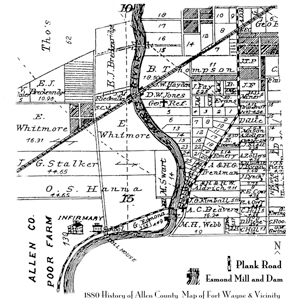THE ESMOND MILL
 In the last issue of The Waynedale News, while researching Ed Noble’s history column, I speculated there might have been a grist mill where Rogers Formal Wear & Tubby’s Ribs now sit at Broadway and Bluffton Roads.
In the last issue of The Waynedale News, while researching Ed Noble’s history column, I speculated there might have been a grist mill where Rogers Formal Wear & Tubby’s Ribs now sit at Broadway and Bluffton Roads.
Dave Trainer read our story in The Waynedale News. He copied some maps and some literature about where the grist mill was initially built. The written information provided is from The Water Powered Mills of Allen County, by Roy M. Bates, February 1942 and the map is from The 1880 History of Allen County, Fort Wayne and Vicinity.
The Esmond Mill (known also as the Barnett and Hanna Mill, Fairfield Mill, Beaver Mill and Glenwood Mill).
The first water powered mill erected in Allen County was completed in August 1827 by James Barnett and Samuel Hanna. The mill stood on the St. Mary’s River, a short distance south of the Oakdale Bridge; (Bluffton Road Bridge) in what is now the Sears Pavilion area.
A few years later, the mill was sold to Louis H. Davis, who later sold the business to Asa Fairfield and Samuel Freeman. The former had the distinction of operating the first boat through Fort Wayne on the Wabash and Erie Canal. The business operated under the name of Fairfield and Freeman until the partnership was dissolved and the business purchased by A. C. Beaver, who then named the mill Glenwood.
George Esmond purchased the Glenwood Mill, November 1, 1876, for the sum of $24,000 and operated it until it was completely destroyed by fire, February 27, 1878. On May 31 of the same year, work was begun on Mr. Esmond’s new brick mill and it was completed October 1, at a cost of $20,000. It was a three-story building 44X64 feet in size, and equipped with all new machinery. Its power was developed by one 60 inch and two 56 inch turbine wheels capable of producing from 60 to 80 horsepower. The grinding equipment consisted of one 4 foot and four 3 foot stone buhrs. The mill employed five men and could produce 80 barrels of flour daily. The mill’s storage capacity was 10,000 bushels of grain.
Less than two years after construction of the new mill, on April 26, 1880, the dam was partially destroyed by high water, after which Esmond converted it to steam power. The Esmond Milling Co. was incorporated June 4, 1886, with capital stock of $60,000. On October 4, 1887, Mr. Esmond sold the business to I. S. Tevis of Kentucky and T. S. Proctor of Tennessee. The new proprietors operated the business for a little more than seven months, when on May 15, 1888, the mills were again completely destroyed by fire, with a loss of $40,000, and, after sixty-one years of continuous operation, were never rebuilt.
Thank you Dave Trainer for sharing this information.
- Whatzup Honors Dan Ross With H. Stanley Liddell Award - December 5, 2025
- Step Back In Time For A Traditional Christmas - December 5, 2025
- Holiday Drive-Through Light Display Supports Local Youth - December 5, 2025


